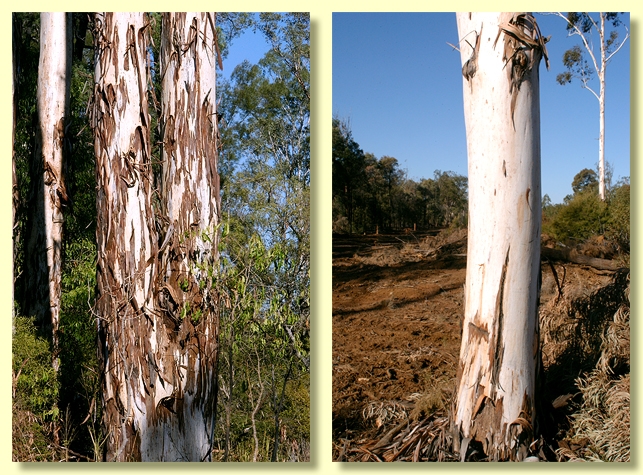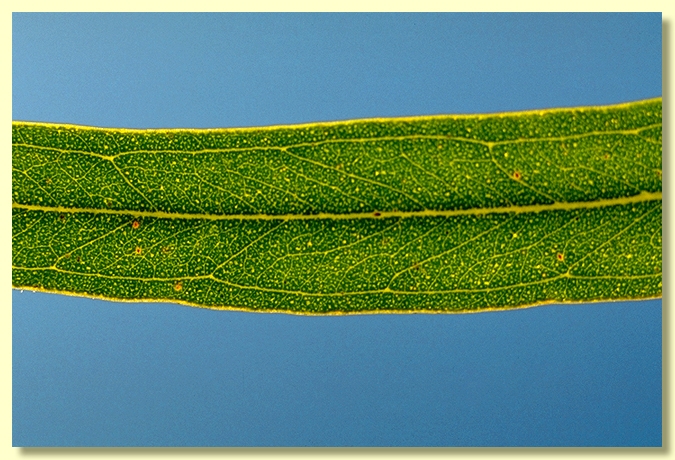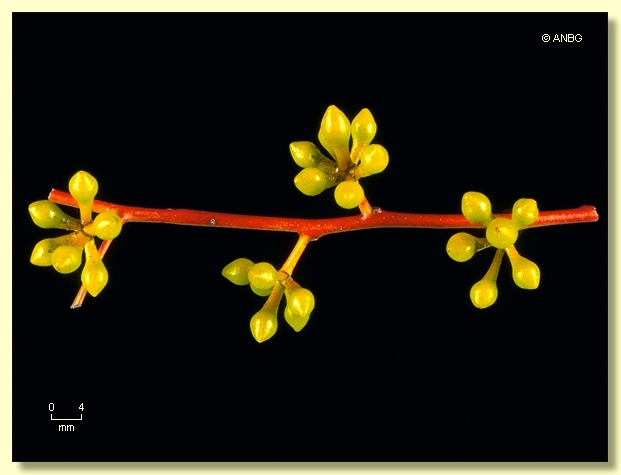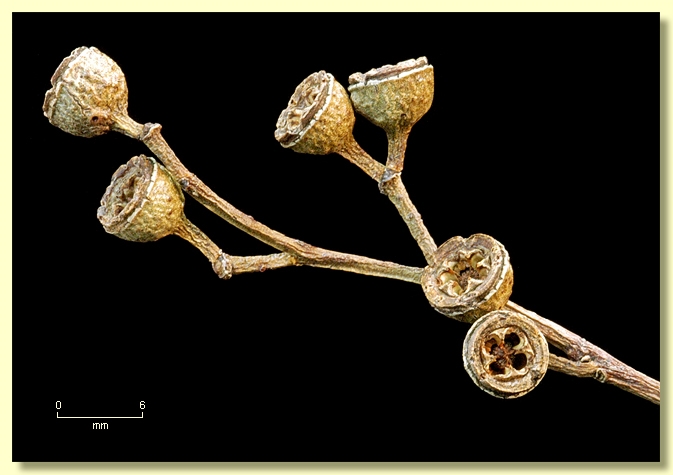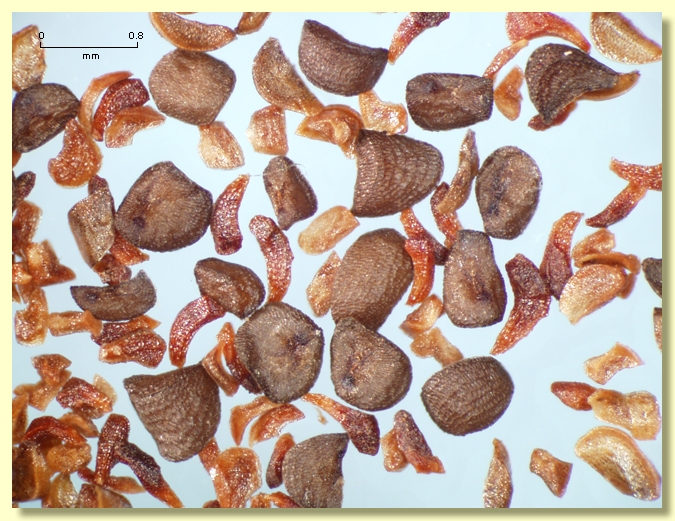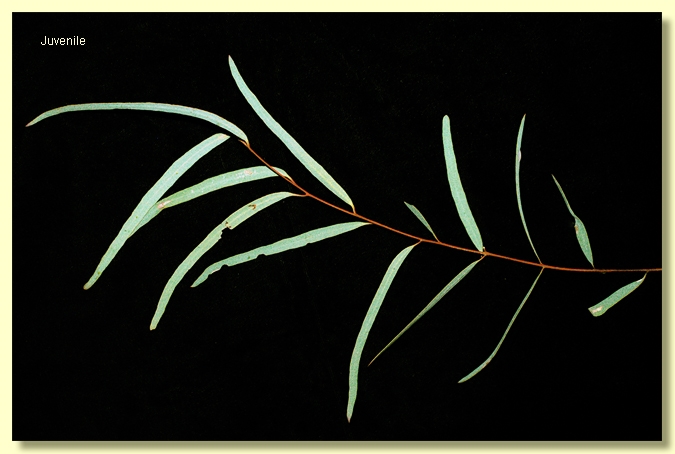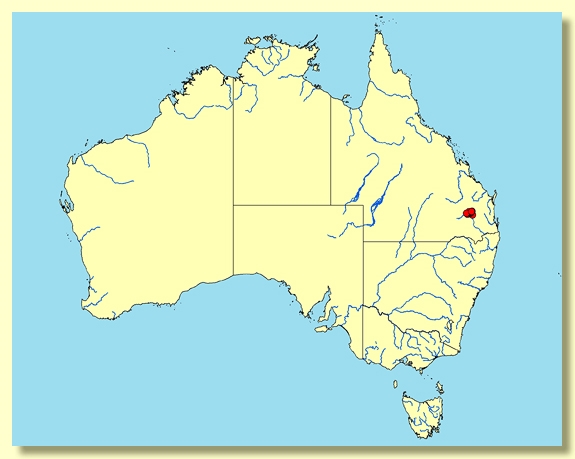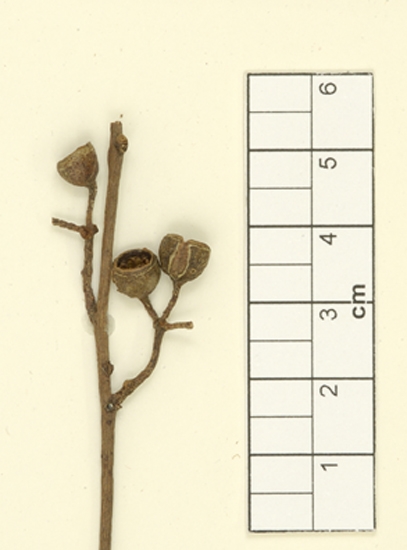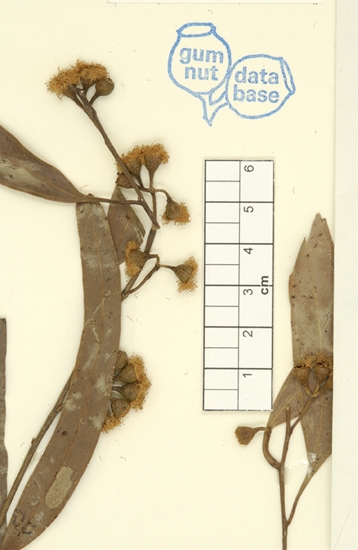Euclid - Online edition
Eucalyptus argophloia
Eucalyptus | Symphyomyrtus | Adnataria | Apicales | Submelliodorae
Eucalyptus argophloia Blakely, Key Eucalypts 256 (1934).
T: Queensland: c. 12 miles [19.3 km] N of Chinchilla, May 1933, R.C.Beasley s.n.; lecto NSW40185; isolecto: BRI AQ094179; K000347651; fide Bean, A.R., Telopea 12(3): 309 (2009).
Tree to 30 m tall. Forming a lignotuber.
Bark smooth throughout, sometimes with thin flakes or strips of decorticating bark persisting on the lower trunk. Smooth bark grey or reddish grey or brown over white to creamy-white to yellow.
Branchlets lack oil glands in the pith; non-glaucous.
Juvenile growth (coppice or field seedlings to 50 cm): stems square to round in cross-section; juvenile leaves shortly petiolate, opposite for up to ca 6 nodes then alternate, narrowly lanceolate to linear, 4.5–9 cm long, 0.4–1.4 cm wide, green.
Adult leaves alternate, petioles 0.5–1.5 cm long; blade narrowly lanceolate, 6.5–14 cm long, 0.7–1.5(2) cm wide, base tapering to petiole, margin entire, apex pointed, concolorous, glossy green, rarely dull grey-green to slightly glaucous, side-veins acute, somewhat irregularly spaced, reticulation moderate to dense, intramarginal vein remote from margin, oil glands irregular in shape, mostly island.
Inflorescence axillary single, peduncles 0.5–1 cm long, buds 7 per umbel, pedicels 0.1–0.4 cm long. Mature buds globular to obovoid to ovoid, 0.4–0.6 cm long, 0.3–0.4 cm wide, scar absent (both opercula shed together at flowering), operculum rounded, stamens inflexed, staminodes absent, anthers adnate, basifixed, cuboid to globoid, dehiscing by short lateral slits, style long and straight, stigma pin-head, locules regularly five, rarely 4, the placentae each with 4 vertical ovule rows. Flowers white.
Fruit pedicellate or subsessile (pedicels to 0.6 cm long), hemispherical to cup-shaped, 0.3–0.5 cm long, 0.5–0.7 cm wide, disc descending vertically, valves regularly five, rarely 4, near the rim.
Seeds brown, 0.8–1 mm long, flattened-ovoid, dorsal surface shallowly reticulate, hilum ventral.
Cultivated seedlings (measured at ca node 10): cotyledons reniform; stems square in cross-section; leaves always shortly petiolate, opposite for 6 to 8 nodes then becoming alternate, linear to narrowly lanceolate, 4.5–10.5 cm long, 0.3–1.2(1.8) cm wide, intramarginal vein prominent and well removed from the margin, green to grey-green, dull, discolorous. Seedlings highly branched.
Flowering has been recorded in May and June.
An eye-catching and well-formed medium-sized to tall tree restricted to an area north-east of Chinchilla on the Darling Downs in south-east Queensland, from near Jandowae, west through the Burncluith–Pelican–Burra Burri area to the Barakula State Forest. Characterised by its smooth bark over the entire trunk, it has glossy green adult leaves with the secondary venation somewhat irregularly spaced and at an acute angle to the midrib, buds in axillary umbels and hemispherical to cup-shaped fruit, regularly with five valves.
Eucalyptus argophloia belongs in the sub-genus Symphyomyrtus, Section Adnataria (the boxes and ironbarks) because of its adnate anthers, retention or the sepaline operculum to flowering time and small reniform cotyledons, but within this group it is isolated in series Coalitae subseries Submelliodorae, with the Victorian and New South Wales coastal species E. bosistoana as its only close relative. The tall forest tree stature, smooth bark, seven-budded axillary inflorescences and fruit with five valves make E. argophloia a bit of an oddity. It is unlikely to be confused with any other species within its natural range.
In Queensland it is most likely to be confused with E. thozetiana, another species which can be entirely smooth barked, and with E. ochrophloia, E. cambageana and E. orgadophila, species with basal rough bark but which are conspicuously smooth-barked on the upper trunk and branches.
However E. thozetiana and E. ochrophloia differ by having terminal compound inflorescences, buds with staminodes and cylindrical to barrel-shaped fruit.E. cambageana and E. orgadophila differ by having terminal compound inflorescences, buds with an operculum scar and cup-shaped to barrel-shaped to funnel-shaped fruit.
Within its area of occurrence, there are many other species, outside Section Adnataria, that are well formed trees with smooth bark, that may be confused with E. argophloia. Most of these have buds that shed the outer operculum early in development (leaving an operculum scar). Corymbia citriodora is the only whitish smooth-barked well formed tree in the Barakula area that retains its outer operculum until flowering (no operculum scar). It can be easily separated from E. argophloia on fruit size and shape, urceolate to barrel-shaped in C. citriodora and small hemispherical to cup-shaped in E. argophloia.
Eucalyptus argophloia is listed as "Vulnerable" under the Australian Government Environment Protection and Biodiversity Conservation Act 1999. See this link for further information
http://www.environment.gov.au/cgi-bin/sprat/public/sprat.pl
Eucalyptus argophloia: Greek argos , white, bright and phloios , bark, referring to the white bark.


